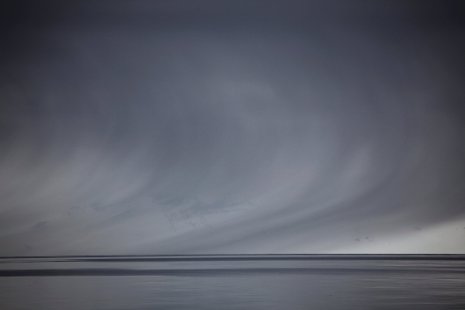Why it Snows so Much in the Frozen North

When it doesn’t show signs of stopping, most of us just mumble a few choice words and get out the snow shovel. Scientists, however, wonder where all that snow is coming from, particularly in pristine places like the Arctic. Raymond Shaw and his colleagues may have found an answer.
Here’s the conundrum: Snow doesn’t just materialize out of thin air. For those delicate, six-sided crystals of ice to form, they need a nucleus, a speck of dust, where water molecules can cling and order their structure as they freeze. Those ice-forming nuclei are relatively rare. Yet, over the Arctic, where the atmosphere is very clean and the ocean is covered with ice, sometimes it snows interminably. With bazillions of snowflakes crystalizing over dust specks and falling to Earth, why don’t the clouds run out of nuclei? And why doesn’t it quit snowing?
The same question applies to a lesser degree in places like Lake Superior, whose soggy clouds drop countless megatons of snow on the hapless residents of Minnesota, Wisconsin and Michigan.
“Within a few hours, you basically purge the atmosphere of all those particles,” said Shaw, a physicist at Michigan Technological University. “So how can it snow for days on end?”
To answer the question, Shaw and his colleagues, including graduate student Fan Yang, set about developing a model to describe how ice crystals form, grow and fall, and they backed it up using data on arctic clouds, which are very well studied. They hoped that by characterizing just how snow comes into being, they would uncover clues to the puzzle.
What they discovered surprised them. As the number of snow crystals increases, their mass soars by a power of 2.5. “Our first guess would have been that if you triple the number of crystals, you triple the mass,” said Shaw. “It turns out to be a much stronger relationship than that.” For example, if you triple the number of crystals, the mass goes up by a factor of 16. Simply put, the more crystals you have, the bigger they are.
Their model hinges on the idea that ice crystals are forming on atmospheric particles that were previously thought to be useless for making ice crystals. “The key assumption we made was that there’s a hidden source of ice nuclei that’s always there, but they are just really, really low efficiency,” said Shaw. “The consensus in the research community has been that you need special pieces of dust to catalyze the ice. We thought, ‘What if there was more stuff out there that would produce ice if you just wait long enough? Maybe when you put it in contact with a drop of water, it doesn’t freeze immediately. But if you wait an hour, or two hours, it does. Our model assumes that the atmosphere is full of those really inefficient nuclei.”
Those inefficient nuclei are behind those big crystals that show up during heavy snowfalls.
“The mass of an ice crystal is related to its growth time,” Shaw said. “The longer it’s in the cloud, the bigger it will be.” So, when there’s an updraft that keeps crystals from falling, snowflakes that form on regular, snow-forming particles get larger and larger. During that time, many more snowflakes have a chance to form on weak nuclei.
Eventually, all the snow crystals get too heavy for the updraft to support, and they tumble earthward. By then, they are huge, and there are lots of them. Not only is that born out in Shaw’s model, it also appears to fit with data gathered from arctic clouds.
They don’t know what those weak nuclei are, or where they come from. But the scientists on Shaw’s team are confident enough in their existence that they are looking for them in lab experiments.
“By assuming they are there, we got this mathematical prediction that fits with the experimental data,” said Shaw. “So there’s indirect evidence that these inefficient nuclei are there. This could be a solution to the mystery.”
The study was funded by the US Department of Energy. An article describing their work, “Minimalist Model of Ice Microphysics in Mixed-Phase Stratiform Clouds,” coauthored by Shaw, Yang and Mikhail Ovchinnikov, a research scientist at Pacific Northwest National Laboratory, was published in the July 2013 edition of Geophysical Research Letters.
Michigan Technological University is an R1 public research university founded in 1885 in Houghton, and is home to nearly 7,500 students from more than 60 countries around the world. Consistently ranked among the best universities in the country for return on investment, Michigan's flagship technological university offers more than 185 undergraduate and graduate degree programs in science and technology, engineering, computing, forestry, business, health professions, humanities, mathematics, social sciences, and the arts. The rural campus is situated just miles from Lake Superior in Michigan's Upper Peninsula, offering year-round opportunities for outdoor adventure.




Comments